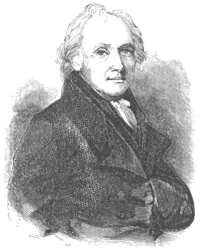Weems–Botts Museum
|
Weems–Botts House | |
_001.jpg) | |
|
Weems-Botts House | |
 | |
| Location |
Corner of Duke Street and Cameron Street Dumfries, Virginia |
|---|---|
| Coordinates | 38°34′07″N 77°19′49″W / 38.56861°N 77.33028°WCoordinates: 38°34′07″N 77°19′49″W / 38.56861°N 77.33028°W |
| Area | 1.6 acres (0.65 ha) |
| Governing body | Private |
| NRHP Reference # | 75002029[1] |
| VLR # | 212-0010 |
| Significant dates | |
| Added to NRHP | May 12, 1975 |
| Designated VLR | April 15, 1975[2] |
Weems–Botts House Museum is a small, professionally directed museum in Dumfries, Virginia, USA. The museum includes the historic Weems–Botts House on the corner of Duke Street and Cameron Street and the Weems–Botts Museum Annex on 3944 Cameron Street. The museum features the history of Dumfries, Virginia's oldest chartered town, and two people who lived in the house: Mason Locke "Parson" Weems, and attorney Benjamin Botts.[3]
The house originally served as the vestry for the Quantico Church. In terms of architecture, the part of the building built initially shows an example of a true 1 1⁄2-story building. The museum was restored by Historic Dumfries, Inc. in 1975 as part of a bicentennial U.S. restoration project. A gazebo was also built during the bicentennial to commemorate William Grayson, one of Prince William's most respected citizens.[4]
Historical significance


Parson Weems, a native Marylander, was a clergyman who became an author and purveyor of books, which he would peddle from the back of his jersey wagon. While traveling through Dumfries during one of his book-selling tours, Weems met Fanny Ewell, the daughter of Col. Jesse Ewell, a wealthy tobacco planter with a warehouse business in Dumfries. They married in 1795.
At the house, Weems wrote an 80-page booklet that would influence the thoughts of Americans to this day: he documented the life of George Washington, and was the creator of the famous cherry tree story ("I cannot tell a lie, I did it with my little hatchet"). He also created the fable that Washington threw a silver dollar more than 300 feet across the Rappahannock River. He also wrote biographies on Benjamin Franklin, Francis Marion, and William Penn.[5]
Sometime after the death of his father-in-law in 1805, Weems moved his family into the Ewell family estate, Bel Air. Weems sold his shop in 1802 to an attorney named Benjamin Botts.
.jpg)
Benjamin Botts used the building as his law office. Best remembered as one of the lead lawyers who successfully defended Aaron Burr during his infamous treason and conspiracy trial, Botts was a Dumfries native and rising star in Virginia's legal community. Botts was killed in the Richmond Theater fire on December 26, 1811.
Haunting trivia
According to L.B. Taylor, Jr.'s The Ghosts of Virginia; Volume VII, this museum is haunted. From the time of Botts' death (1811) until 1869, the usage of the home remains unknown. Around 1869, Richard Merchant, his wife Annie, and, eventually, his daughters Violet and Mary moved into the house. Mary suffered from epileptic seizures and was kept in an upstairs room in confinement until she died only a few months before Richard himself. Soon after this, Annie asked her daughter Violet, who had moved away and fallen in love, to come home and take care of her. Violet obliged and apparently lived a lonely and sad life with her mother until Annie died at 98 years of age in 1954. Violet spent the rest of her days in solitude and died thirteen years later in 1967.
In 1974, when major reparations were being made to the house/future museum, the strange occurrences began. Taylor provides several examples including an instance where books began to fly off shelves by invisible forces, an instance of a Boy Scout troop leader having a vision of Mamie asking for her rocking chair (which she sat in quite often when she was alive), and the fact that a closet in the upstairs bedroom opens by itself everyday.
References
- ↑ "National Register Information System". National Register of Historic Places. National Park Service. 2010-07-09.
- ↑ "Virginia Landmarks Register". Virginia Department of Historic Resources. Retrieved 5 June 2013.
- ↑ Historic Dumfries Virginia, Inc
- ↑ Prince William County Historical Commission. Wieder, Laurie C.: Editor. Prince William: A Past to Preserve. Prince William County Historical Commission: Publisher. 1998. Ref. p. 31.
- ↑ Taylor, L.B. Jr. The Ghosts of Virginia, Volume VII.Progress Printing, Co, Inc., USA. 2002.
External links
| Wikimedia Commons has media related to Weems–Botts Museum. |

